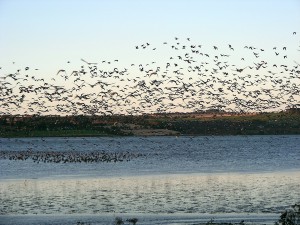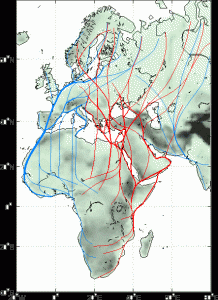Migration – The Basics
April is the prime month for seeing the return of many of our summer migrant species, weather depending, but what is migration and why does it occur!? Fear not as here is a quick guide to the whys, where, when’s and how’s of migration.

Why?
A common definition of migration is that it’s a journey with a clear purpose from one area to another, often following a well-defined route to a familiar destination, and often at a specific season or time. But there is no universally accepted definition of the word migration, as it takes place in many way, shapes and forms.
The main reason animals migrate is to escape adverse conditions by moving to areas in which conditions are more favourable for their own and their offspring’s survival. In other words, migration is the fight to survive. There is a long list of conditions that force animals to migrate, including: lack of food, adverse weather conditions, the need to find water or essential minerals, overcrowded conditions, the need to find a safe place to moult, to find a partner to mate with, to give birth, lay eggs or to have a safe place to raise their offspring. In most cases it is a combination of these factors hat drive the species migrate.
When?
Migration across the globe can take place at anytime, but is most commonly driven by the changing seasons. The Earth’s movement and orientation in relation to the Sun dictates the planet’s seasonal cycles and these in turn have a profound impact on its wildlife. Areas that are favourable in summer become hostile in winter, pushing the animals to go in search of these more favourable conditions. Whilst the Northern Hemisphere basks in summer, the Southern Hemisphere is experiencing the harsh conditions of winter, and vice versa. This is why in the UK we see the departure of our breeding species such as Swallows and Sand Martins at the end of our summer as they move out before our colder weather arrives, and we see the arrival of migrant Geese and Swan species in the Autumn as they escape the harsher winter conditions of the Arctic.
Where?

The classic type of migration, and by far the most common type, as carried out by most avian migrants consists of flying north and south between summer and winter ranges, also known as latitudinal migration. Many of the common migratory species found in the UK fall into this category, including Osprey, Swallows, Sand Martins and the Swan and Geese Species. There are however, many other types of migration taking place across the globe, such as; circuits of the land and ocean and altitudinal migration up and down mountains as seen in North American Quails and also in Copepods, tiny sea crustaceans that migrate up and down the oceans water columns.
How?
There are many theories regarding how animals manage to be in the right place at the right time, how they manage to set off together at the same time every year and manage to return to the exact area or nest as the year before. Animals must have some kind of inbuilt clock, but they way these clocks are triggered and function isn’t yet fully understood. There are thought to be two types of so called rhythms, Circadian and circannual that work together to create these perfectly calibrated clocks. Circadian rhythms are strict 24 hour cycles that govern things such as feeding, sleeping and metabolism whilst circannual rhythms are much longer term cycles that are triggered by stimuli such as gradually changing day length and the yearly sequence of the seasons. These rhythms are unique to each species, and it is through the combination of these deep-set mechanisms that each species is able to plan and coordinate their journeys so successfully.
Once the animals have been told by their body clocks that the time is right to migrate, they then have various ways of navigating to their destinations. Birds are a good example to use, as they can employ a range of methods to help them find their way. They are known to use different visual landmarks throughout their journey, such as mountains or bodies of water, along with using the sun to navigate during daylight and the stars at night. Birds can also use the Earth’s magnetic field to help them navigate, made possible using the magnetic substance magnetite. This substance, which has been found in the beaks of different bird species, reacts to the Earth’s magnetic field and allows the bird to orientate itself in accordance. Although each of these senses plays a big part in the ability of animals to migrate, the most vital factor is genetics. Migration is instinctive, most migrants brains are programmed to tell them to set off on a specific route, in a specific direction at a given moment of time.
So that’s the basics of migration, all we need now is for some of our migrants to start returning home. At present the Osprey is the only main migrant to have made its return to Montrose Basin, so come down and help us keep an eye out for anymore arrivals, or just keep an eye out for our blog updates.
Craig Shepherd,
Visitor Centre Assistant Manager.
Help protect Scotland’s wildlife
Our work to save Scotland’s wildlife is made possible thanks to the generosity of our members and supporters.
Join today from just £3 a month to help protect the species you love.
Preface
April is the prime month for seeing the return of many of our summer migrant species, weather depending, but what is migration and why does it occur!? Fear not as …
